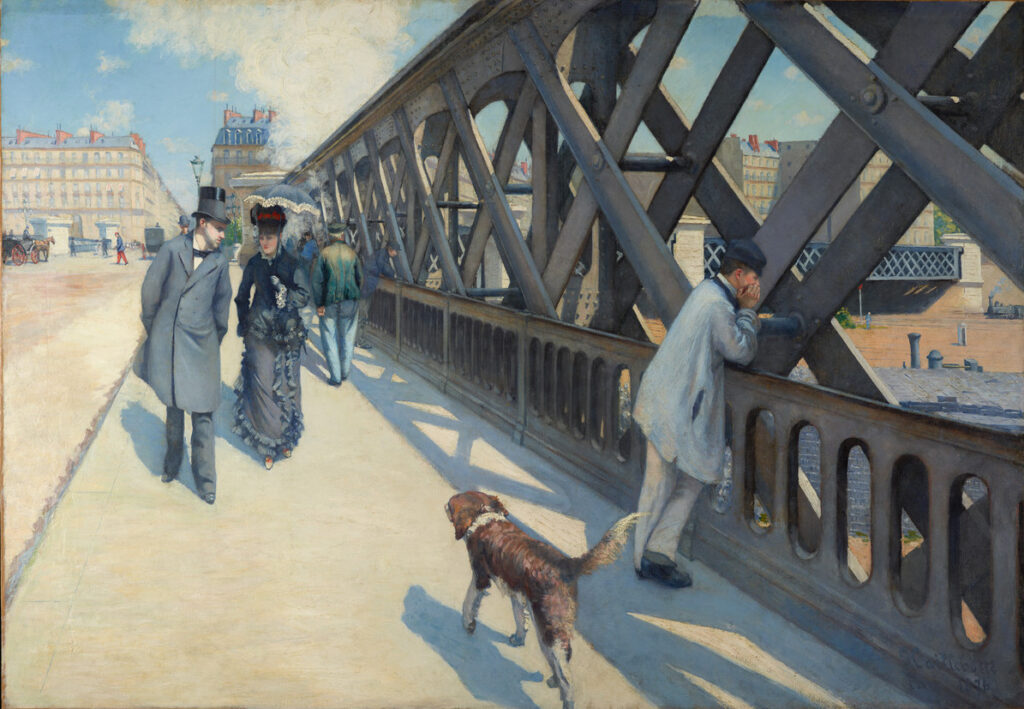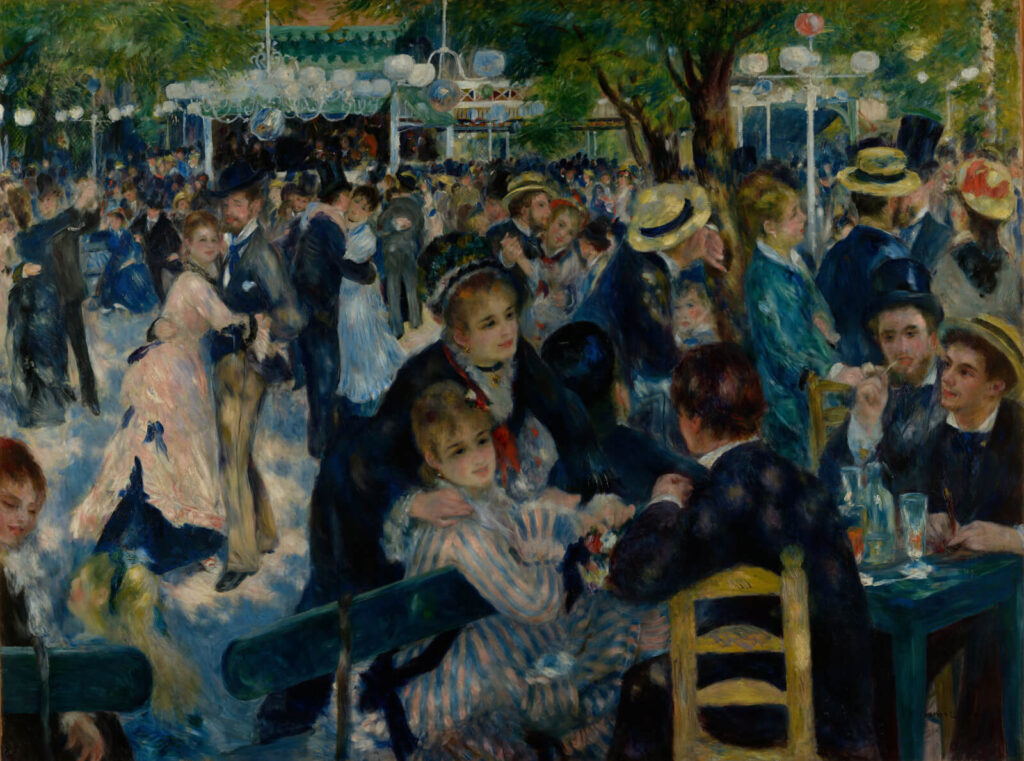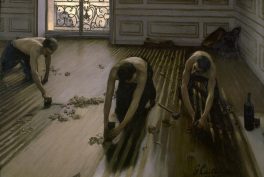Summary
- Like all the Impressionists, Gustave Caillebotte painted Paris during its modern Haussmann era.
- Caillebotte painted a whole series of balconies, showing a bird’s eye view of the city’s streets. These are much less immersive and evocative than other Impressionist works.
- In his street scenes, Caillebotte focused on architecture as much as the people. He used clear light, limited color and exaggerated perspective to show the scale of his subjects.
- Like other artists, Caillebotte sought out scenes of leisure and pleasure. But this is primarily through a restrained middle-class experience. When he does represent the working class, he shows them in action, industriously contributing to the life and wealth of the city.
- Most other male artists of the time preferred to show pretty young women in their works. Caillebotte represented a male dominated world—his men had wealth, status, and authority.
A New Paris
The Paris we know today was almost entirely created by Napoleon III and his architect Baron Haussmann during the 1850s and 1860s. Old narrow streets and insanitary slums were ruthlessly bulldozed to make way for straight, tree-lined boulevards. These wide streets of stone apartment blocks, five or six stories high, with ground-floor shops, ironwork balconies, and mansard roofs became the symbol of a light, airy, modern city. It was hardly surprising that they were featured in so many paintings by Impressionists who wanted to capture the fast-changing world around them.
Caillebotte’s Balcony View

Gustave Caillebotte, The Man on the Balcony, Boulevard Haussmann, 1880, private collection.
Gustave Caillebotte (1848–1894) lived right in the center of this shiny, new Paris. The family home had been built by his father, who had made money out of the property boom, on the corner of Rue de Miromesnil and Rue de Lisbonne. Caillebotte and his brother later shared a sixth-floor bachelor apartment on Boulevard Haussmann. In numerous paintings, including Man on the Balcony, he shows us the view of the city, looking out from his own home.
The day is bright, the sky is blue, and the striped awning gives the picture a jaunty color and an almost festive air. The architecture is unmistakably Haussmann, but the city seems distant: we cannot see the street below because of the fluff of green leaves, the ornate ironwork of the railings, and the flowers in the planter. Caillebotte places the viewer inside the apartment. Shadowing the gentleman, we are even more detached from the scene. Would we even hear the noises coming up from the street?
Impressionist Paris

Claude Monet, Le Boulevard des Capucines, 1873–1874, Pushkin State Museum, Moscow, Russia.
Other artists, like Claude Monet (1840–1926) and Camille Pissarro (1830–1903) used a vantage point to show crowds and motion or to investigate the nuances of different weather and times of day. In Le Boulevard des Capucines, Monet makes the city hum with movement as a blur of tiny figures rush about their lives. He juxtaposes deep shadow with strong sunlight, a direct effect of the tall apartment blocks that line the street. He uses the complex pattern of the branches of the trees to add to the sense of movement and confusion. On the right of the picture, two men look down: we are experiencing what they see.
Like his fellow Impressionists, Caillebotte was attracted by the almost bird’s eye view the balconies gave him, by the odd angles and juxtapositions of the buildings. However, he usually depicts clear sunshine and few people. It is Paris itself that appeals. He represents the city with cool detachment rather than immersed enthusiasm.
Caillebotte’s Engineering Art

Gustave Caillebotte, On the Pont de l’Europe, 1876–1877, Kimbell Art Museum, Fort Worth, TX, USA. Museum’s website.
When Caillebotte leaves his apartment and ventures out into the street, he retains his preoccupation with the structure of the city. The subject of On the Pont de l’Europe is the dramatic crisscross of iron girders, riveted together with precision engineering, and the whole painting takes its color scheme from the steel-blue metal. Pont de l’Europe had only been built about ten years when Caillebotte painted it. It was considered one of the great structural masterpieces of modern Paris, built to span the tracks of the Gare St Lazare station below.
In Caillebotte’s interpretation, the two male figures look towards the bridge, but we can only guess at what draws their gazes because ours is stopped by the might of the structure. Caillebotte painted this partly en plein air, working at the same time as Monet was painting his images of the Gare St Lazare. Yet whilst Monet is attracted to the smoke and steam of the trains, you have to strain into the distance to even know there is a railway in Caillebotte’s work.
Academic Paris

Jean Béraud, The Place and Pont de l’Europe, 1876–1878, private collection (Wikimedia Commons)
The radicalism of Caillebotte’s interpretation of Paris is even more evident when viewed alongside the work of artists like Jean Béraud (1849–1835). Béraud produced popular images of Paris that combined a more conventional Academic finish with the use of casual, photography-inspired compositions. His paintings give the impression of moments in city life being captured whilst presenting, at the same time, a series of carefully created points of interest, narrative, and humor.
For Béraud, Pont de l’Europe is just a convenient backdrop for his stage set action. An elegant woman, a stray dog, a young boy delivering flowers, a girl pulling away from her nurse. If you look very closely at the back left, you can see a man leaning over the bridge just like in the Caillebotte. Béraud sees the city through the Parisians, whereas Caillebotte is prioritizing his interest in the architecture of Paris over those who live there.
Caillebotte’s Perspective Drama

Gustave Caillebotte, Pont de l’Europe, 1876, Musée du Petit Palais, Geneva, Switzerland.
The same interest continues in Caillebotte’s second, more famous view of Pont de l’Europe. Superficially, the painting makes more concessions to Béraud’s narrative style, with its dog, the female figure, and the posing of the man in the top hat. It could almost be a snapshot captured a few seconds before the Kimbell version, with the same smocked worker leaning on the bridge and the well-dressed man about to draw level.
However, again the structure of the bridge is the real subject, and the figures fail to really attract our attention. The dramatic engineering is emphasized by Caillebotte’s attention to the detail of the architecture and his compositional choices. In this case, his use of strong sunlight creates a mirror shadow of the girders on the ground. Most strikingly, his use of exaggerated, funnelling perspective makes the road and the ironwork rush towards us.
Paris Street

Gustave Caillebotte, Paris Street, Rainy Day, 1877, Art Institute of Chicago, Chicago, IL, USA.
Caillebotte exploits the same effect in Paris Street, Rainy Day, where the steep triangle of the background buildings makes us more aware of their height and the impressive, straight length of those Haussmann streets. The street lamp bisects the painting, and as in the Kimbell Pont de l’Europe, Caillebotte crams his main figures into half of it. The umbrella-holding couple are not looking at us and as we approach them. We barely give them a glance, as our attention is drawn across the cobbles and towards the strong geometry of the background architecture.
The crisp, clean, sleekness of the architecture, magnified by the sheen of wetness, again suggests the enthusiasm that the artist felt for this modern world. Similar pictorial devices would later be used to generate excitement for the urban landscape in the work of American Precisionists, like Georgia O’Keeffe, who celebrated 1920s New York.
The Parisian Middle Class

Gustave Caillebotte, Man at the Window, 1876, J. Paul Getty Museum, Los Angeles, CA, USA.
Caillebotte’s Paris exudes wealth as well as modernity. He came from a middle-class background and his art has a restraint and propriety which reflects that. Rainy Day takes its color scheme from the top hat and overcoat of the gentleman in the foreground. His wealth and status are defined by his clothes, as well as by the confidence with which he walks through this well-to-do neighborhood.
Similarly, the men standing proudly on the balconies of their well-appointed apartments exude money and confidence. The wide power stance of the Man at the Window, his hands in his pocket, tells us as much about his status as does the well-upholstered chair in the foreground and the weighty marble of the balustrade. The strong sunlight here is not just a coincidence: it is synonymous with the bright, warm, optimism which comes with wealth and privilege.
Caillebotte and Respectability

Pierre-Auguste Renoir, Dance at Le Moulin de la Galette, 1876, Musée d’Orsay, Paris, France.
Impressionist Paris is a place of fun, entertainment, and leisure. Pierre-Auguste Renoir (1841–1919) goes to the theatre and dances in Montmartre, Edgar Degas (1834–1917) frequents the ballet and the races, Édouard Manet (1832–1883) listens to music in the Tuileries Gardens, Monet hangs out on the river. Despite differences in style, their works show crowds, liveliness, and color, with brushwork and composition employed to emphasize noise, movement, and chaotic excitement.
Caillebotte, in contrast, presents a life of restraint and propriety: a family lunch, a game of cards, a private piano recital. Later, when he began portraying rowers and canoeists, they are serious sportsmen or men who keep their top hat on even when exerting themselves on the river. His street scenes show soberly dressed individuals going about their daily business. His whole colour scheme underlines that sense of restraint. The sense of space, the distance between figures, the straight lines all emphasize propriety and ordered calm.
Paris as a Working City

Gustave Caillebotte, The House Painters, 1877, private collection.
When Caillebotte does show other social groups, he shows them with purpose, working for the economic benefit of the city. Most famously, he showed The Floor Scrapers in a series of works. They were probably painted as he watched men preparing the boards of his own studio. Later he would represent gardeners. In The House Painters, Caillebotte shows painters working on the shops, which filled the ground floors of the apartment blocks. Using a typically near-monochrome palette, working men in their smocks are seriously getting on with the job, oblivious of us. In this case, Caillebotte’s characteristic exaggerated perspective suggests the never-ending nature of their task.
Look hard and working people are always there in the street scenes. In the background of Rainy Day, you can just see a maid, a decorator carrying a ladder; a smock-wearing laborer takes a break in the Pont de l’Europe paintings. Work and commerce are at the heart of Caillebotte’s interpretation of the city.
Caillebotte as a Man About Town

Gustave Caillebotte, A Balcony, Boulevard Haussmann, 1880, Thyssen-Bornemisza Museum, Madrid, Spain.
Caillebotte’s Parisian scenes are dominated by men. Whereas Renoir chose to show the rain through a crowd of umbrella-carrying young women, Caillebotte has a respectable couple and a street sparsely populated by mainly men. Manet’s Balcony has a mixed group of figures, two women and a man, who we look across at, so that balcony becomes a stage. Caillebotte, in an almost direct reversal, shows the backs or profiles of men standing and observing the world.
Equally, Manet’s Gare St Lazare painting, usually known as The Railway, shows a young woman and girl rather than men. Their voluminous dresses and the woman’s flowing hair act as a deliberate contrast to the rigid, black verticals of the iron railings directly behind them. They are the object of our gaze, not the architecture or the station.

Édouard Manet, The Railway, 1873, National Gallery of Art, Washington DC, USA
Caillebotte’s Masculinity
Some critics have suggested that this homocentric view reflects Caillebotte’s own sexuality, even going as far as to say that the gentleman in Pont de l’Europe is checking out the worker who leans off the bridge. Whether one wants to argue that or not, the male focus of Caillebotte’s paintings reflects the late 19th-century reality. Women’s lives, particularly those of the middle classes, were more restricted They did not work; they were less likely to be out and about, especially on their own.
Caillebotte is expressing the opposite of those artists like Berthe Morisot (1841–1895) who portrayed the domestic reality of middle-class women, with their interior and garden scenes, and their focus on children and motherhood. The urban space was a man’s world.
Caillebotte’s Impressionism

Gustave Caillebotte, Rooftops in the Snow (Snow Effect), 1878–1879, Musée d’Orsay, Paris, France.
Caillebotte’s Parisian scenes date mainly from the 1870s. In his later career, he spent less time in the city and shifted towards a more impressionistic style and an interest in landscape subjects. The crisply painted, cool-colored scenes for which he has become most famous were always alongside more obviously Impressionist canvases. He explored different weather effects, noticeably a series of works looking at buildings in the snow.
Equally, he sometimes employed more visible, dashed brushstrokes and a color-based palette. Rue Halévy, View from the Sixth Floor uses soft pinks, blues, and oranges. Heavy impasto clouds, draw your eye to the sky, not the architecture, and suggest sunlight breaking through. The buildings themselves shimmer in the light, suddenly less solid. This could almost be a painting by Monet, were it not perhaps for the emptiness of the street.

Gustave Caillebotte, Rue Halévy, View from the Sixth Floor, 1878, Museum Barberini, Potsdam, Germany.
Caillebotte’s Ambiguity
That variation in style is part of Caillebotte’s ambiguity. Sometimes he seems drawn to the light and color approach of Monet and Renoir; sometimes he focuses on the observational realism of Manet and Degas. Ultimately, his views of Paris are also deeply ambivalent. The more one looks at his paintings, the less clear they become. Is the empty space and the looming architecture an endorsement of the modern city, or is it alienating? Edvard Munch (1863–1944) turns his urban street scenes into nightmares, using many of the same perspectival devices.
Does Caillebotte endorse all that middle-class conformity, or are his respectable men as confined by their buttoned-up collars as Morisot’s women? Does he actually have more empathy for the working population who do not have to idle their time away? Are his apparently powerful men not so much surveying the world as keeping apart from it, perhaps hiding their sexuality?

Gustave Caillebotte and his Dog on the Place du Carrousel, Paris, c. 1892. Photograph by Martial Caillebotte. Wikimedia Commons (public domain).
Like Edward Hopper (1892–1967) would go on to do in 1930s America, Caillebotte shows us the reality of modern urban living. What makes his views of Paris so compelling is less that they represent a glimpse into the past, than that they resonate with our experience today.



